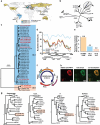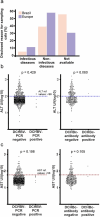Ancient origins and global spread of domestic cat hepatitis B virus
- PMID: 40395614
- PMCID: PMC12091157
- DOI: 10.1093/ve/veaf025
Ancient origins and global spread of domestic cat hepatitis B virus
Abstract
Mammalian hepadnaviruses have likely been evolving alongside their hosts for millions of years. Domestic cat HBV (DCHBV) has been detected in cats from several countries, but its genealogy, epidemiology, and host range remain unclear. Besides DCHBV, the only hepadnavirus identified among carnivores is the ringtail HBV (RtHBV). Because there is a gap in the felid fossil record of approximately 5-7 million years between the late Oligocene and the early Miocene, carnivore-derived viruses might help to shed light on Felidae evolution. Here, we screened 2260 sera and 154 paraffin-embedded liver samples from cats and 2123 sera from dogs sampled in Europe and South and Central America between 2018 and 2020 by PCR for DCHBV. We identified DCHBV genotype A (GtA) in 0.6% (7/1,195; 95% CI, 0.2-1.2) of cats sampled in Germany, France, Croatia, and Bulgaria and a genetically divergent DCHBV genotype B (GtB; 10.8% genomic sequence distance) in 0.2% of cats (2/1,065; 95% CI, 0.0-0.7) from Brazil. The detection rates of the two genotypes did not differ significantly (Fisher, P = .19). Viral loads ranged from 4 × 101-6 × 106 for DCHBV GtA to 5-7 × 103 for DCHBV GtB DNA copies per milliliter of serum. None of the cat livers or dog sera tested positive by PCR. Immunoglobulin G against the DCHBV core antigen (anti-DCHBc) was detected in 8/504 cat sera (1.6%; 95% CI, 0.7-3.1), without significant variation between countries (χ2, P = .17), and in none of 180 dog sera by indirect immunofluorescence assay (IFA). Neither IFA (Fisher, P = .11; n = 311) nor PCR (Fisher, P = .63; n = 699) positivity was significantly associated with increased liver enzymes in cats, respectively. Coevolutionary reconciliations of virus and host phylogenies and Bayesian hypothesis testing suggested evolutionary origins of DCHBV during the Miocene, ∼8-17 million years ago (mya) from ancestral carnivores, consistent with long-term evolution. The long-term association of DCHBV with felines aids in elucidating orthohepadnaviral infection patterns and felid genealogy.
Keywords: animal models; carnivores; hepatitis b; neotropics; viral evolution.
© The Author(s) 2025. Published by Oxford University Press.
Conflict of interest statement
None declared.
Figures




References
LinkOut - more resources
Full Text Sources
Miscellaneous

